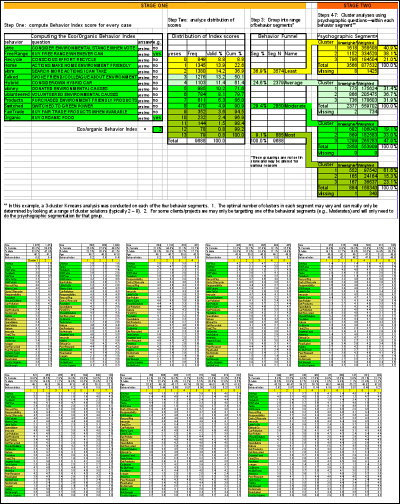| Creativity in data analysis: the art of consumer segmentation |
| One of the creative professional services I offer is the statistical analysis of data. Much of my graduate school training was coursework in advanced inferential statistics. The statistical analysis of data is normally considered to be a very dry, rational left brain activity, but I have found that there is a lot of use for creativity even here--both left brain and right brain creativity. I help companies bring new and more creative approaches to designing research, analyzing data, and finding insights in their consumer data. Here's one example of recent work: dividing consumers into different groups based on their environmental attitudes and behaviors. On the project illustrated here, I helped Initiative Media's research folks analyze a large national sample of data focusing only on questions related to environmental and recycling attitudes--a topic of great interest to them and most of their clients. They wanted to know how many different groups of "attitudes" there are out there (e.g., greens, anti-fur, recyclers, global-warming deniers, etc) and use this to help them understand the importance and dynamic of these attitudes in their various consumer purchases.  We took a two-step approach. First we divided a large national sample of consumers into a series of groups spanning the range environmental views and behaviors from very pro to very anti. Most people are "in the middle." So then we took these middle or moderate groups and used a statistical grouping technique called cluster analysis to divide them into two, three...up to nine different "attitude" groups. These groups have different patterns of attitudes (e.g., people who recycle but don't buy environmentally friendly products, people who don't recycle and think global warming is a major threat, etc.). Initiatives research staff will pour through the various segmentation schemes and charts I have created for them and will try to match the most relevant consumer segments with their client's products and business goals. The cluster analysis can give us two groups or two hundred different groups. We (using our left brain and right brain) have to sort through these groups and figure out which ones make sense for us to use. There's enough right-brainedness going on in this to make it "an art." |
 |
 |
| © 2008 |